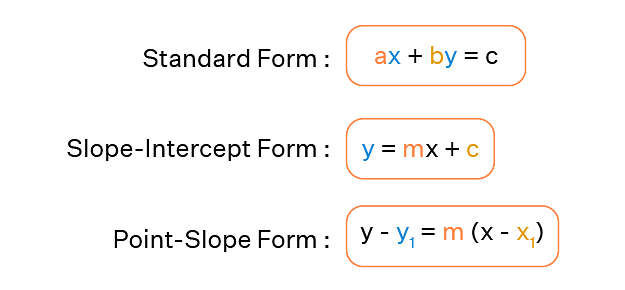In the triangle ABC with vertices A (2, 3), B (4, –1) and C (1, 2), find the equation and length of altitude from the vertex A.
Solution and Explanation
Let AD be the altitude of triangle ABC from vertex A.
Accordingly, \(AD⊥BC\)

The equation of the line passing through point (2, 3) and having a slope of 1 is
\((y - 3) = 1(x - 2)\)
\(⇒ x- y + 1 = 0\)
\(⇒ y - x = 1\)
Therefore, equation of the altitude from vertex \(A = y - x = 1\).
Length of AD = Length of the perpendicular from A (2, 3) to BC
The equation of BC is
\((y+1)=\frac{2+1}{1-4}(x-4)\)
\(⇒(y+1)=-1(x-4)\)
\(⇒y+1=-x+4\)
\(⇒x+y-3=0.......(1)\)
The perpendicular distance (d) of a line \(Ax + By + C = 0\) from a point \((x_1, y_1)\) is given by
\(d=\frac{\left|Ax_1+By_1+C\right|}{\sqrt{A^2+B^2}}\)
On comparing equation (1) to the general equation of line \(Ax + By + C = 0\), we obtain \(A = 1, B = 1\), and \(C = -3.\)
∴ Length of \(AD=\frac{\left|1\times2+1\times3-3\right|}{\sqrt{1^2+1^2}}\) units
\(=\frac{\left|2\right|}{\sqrt2}\) units
\(=\frac{2}{\sqrt2}\) units
\(=\sqrt2\) units
Thus, the equation and the length of the altitude from vertex A are \(y - x = 1\) and \(\sqrt2\) units respectively.
Top Questions on Distance of a Point From a Line
- Find the point on the line \( \frac{x-1}{3} = \frac{y+1}{2} = \frac{z-4}{3} \) at a distance of \( \sqrt{2} \) units from the point \( (-1, -1, 2) \).
- CBSE CLASS XII - 2025
- Mathematics
- Distance of a Point From a Line
- If a point $ P(x, y) $ satisfies the condition that its distance from the point $ (3, -2) $ is equal to its distance from the line $ y = 2x + 1 $, then the locus of point $ P $ is:
- BITSAT - 2025
- Mathematics
- Distance of a Point From a Line
- Find the foot of the perpendicular drawn from the point \( (1, 1, 4) \) on the line \( \frac{x+2}{5} = \frac{y+1}{2} = \frac{z-4}{-3} \).
- CBSE CLASS XII - 2025
- Mathematics
- Distance of a Point From a Line
- Find the point on the line \( \frac{x-1}{3} = \frac{y+1}{2} = \frac{z-4}{3} \) at a distance of \( \sqrt{2} \) units from the point \( (-1, -1, 2) \).
- CBSE CLASS XII - 2025
- Mathematics
- Distance of a Point From a Line
- Find the midpoint of the line segment joining the points (3, 4) and (7, -2).
- AP EAPCET - 2025
- Mathematics
- Distance of a Point From a Line
Questions Asked in CBSE Class XI exam
Figure 8.9 shows the strain-stress curve for a given material. What are (a) Young’s modulus and (b) approximate yield strength for this material?

- CBSE Class XI
- Stress-strain curve
- The reaction CH3CH2I + KOH(aq) \(\rightarrow\) CH3CH2OH + KI is classified as
- CBSE Class XI
- Organic Chemistry - Some Basic Principles and Techniques
Give reasons for the following.
(i) King Tut’s body has been subjected to repeated scrutiny.
(ii) Howard Carter’s investigation was resented.
(iii) Carter had to chisel away the solidified resins to raise the king’s remains.
(iv) Tut’s body was buried along with gilded treasures.
(v) The boy king changed his name from Tutankhaten to Tutankhamun.- CBSE Class XI
- Discovering Tut: The saga Continues
Draw the Lewis structures for the following molecules and ions: \(H_2S\), \(SiCl_4\), \(BeF_2\), \(CO_3^{2-}\) , \(HCOOH\)
- CBSE Class XI
- Kossel-Lewis Approach to Chemical Bonding
- The following results are observed when sodium metal is irradiated with different wavelengths. Calculate (a) threshold wavelength and, (b) Planck’s constant
λ (nm) 500 450 400 v × 10–5(cm s–1) 2.55 4.35 5.35 - CBSE Class XI
- Atomic Models
Concepts Used:
Straight lines
A straight line is a line having the shortest distance between two points.
A straight line can be represented as an equation in various forms, as show in the image below:

The following are the many forms of the equation of the line that are presented in straight line-
1. Slope – Point Form
Assume P0(x0, y0) is a fixed point on a non-vertical line L with m as its slope. If P (x, y) is an arbitrary point on L, then the point (x, y) lies on the line with slope m through the fixed point (x0, y0) if and only if its coordinates fulfil the equation below.
y – y0 = m (x – x0)
2. Two – Point Form
Let's look at the line. L crosses between two places. P1(x1, y1) and P2(x2, y2) are general points on L, while P (x, y) is a general point on L. As a result, the three points P1, P2, and P are collinear, and it becomes
The slope of P2P = The slope of P1P2 , i.e.
\(\frac{y-y_1}{x-x_1} = \frac{y_2-y_1}{x_2-x_1}\)
Hence, the equation becomes:
y - y1 =\( \frac{y_2-y_1}{x_2-x_1} (x-x1)\)
3. Slope-Intercept Form
Assume that a line L with slope m intersects the y-axis at a distance c from the origin, and that the distance c is referred to as the line L's y-intercept. As a result, the coordinates of the spot on the y-axis where the line intersects are (0, c). As a result, the slope of the line L is m, and it passes through a fixed point (0, c). The equation of the line L thus obtained from the slope – point form is given by
y – c =m( x - 0 )
As a result, the point (x, y) on the line with slope m and y-intercept c lies on the line, if and only if
y = m x +c